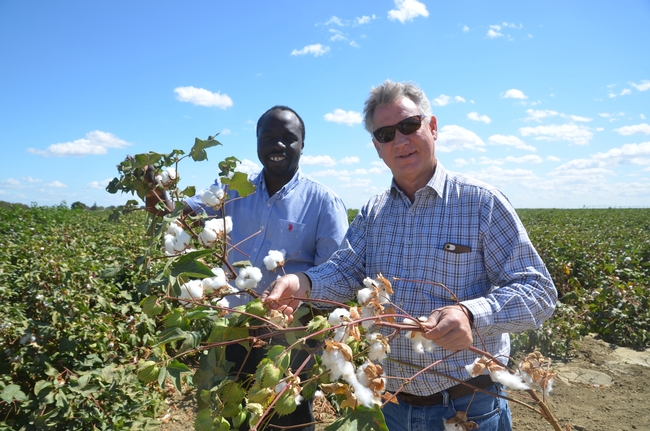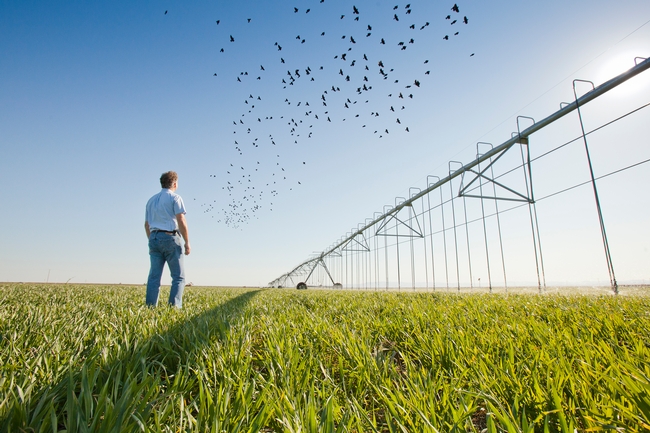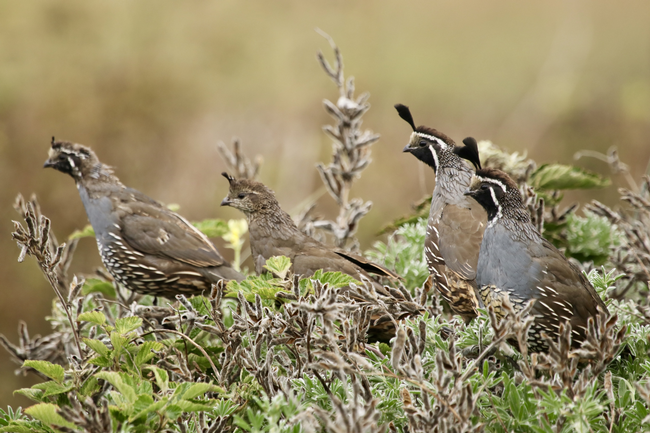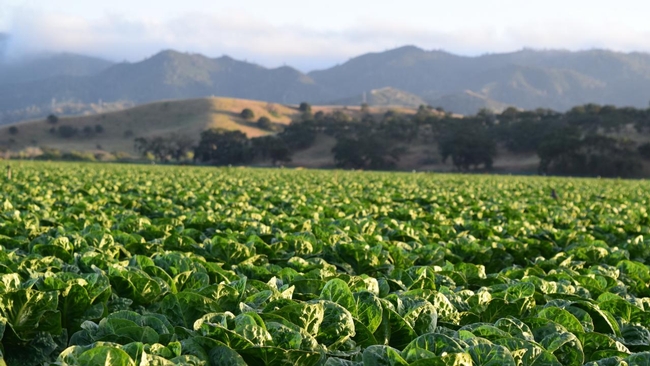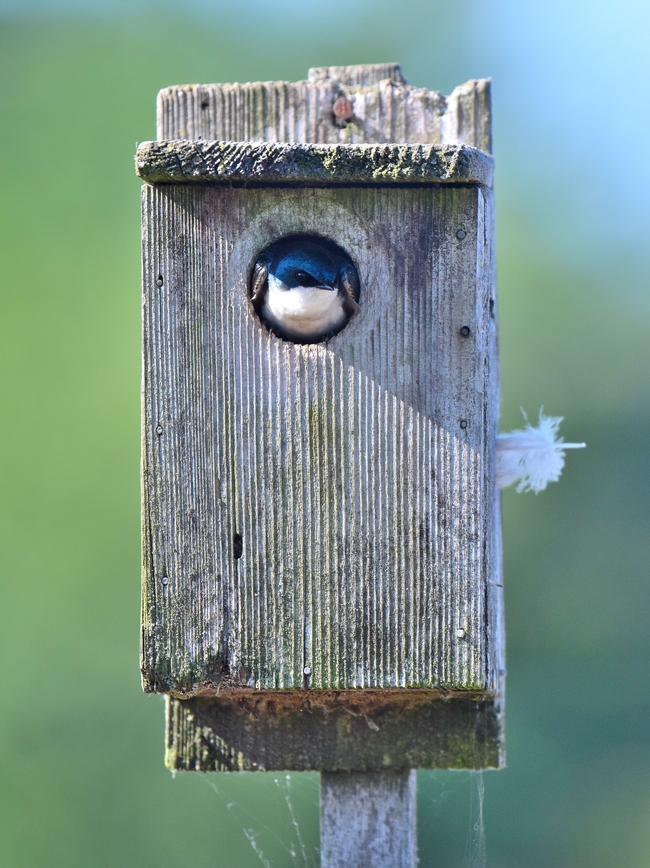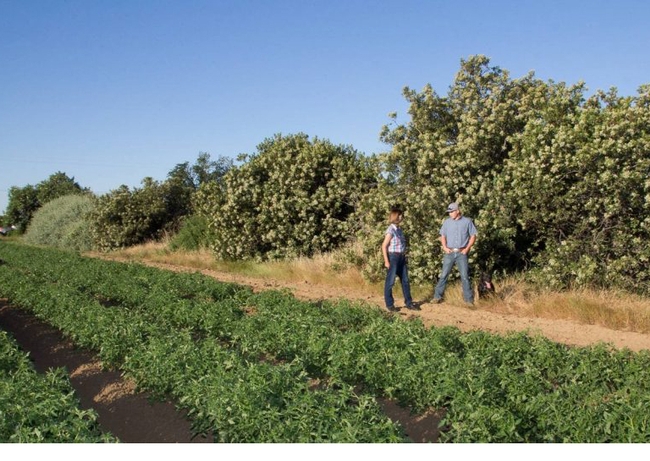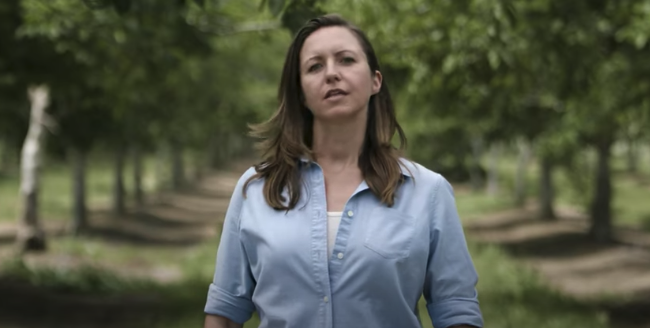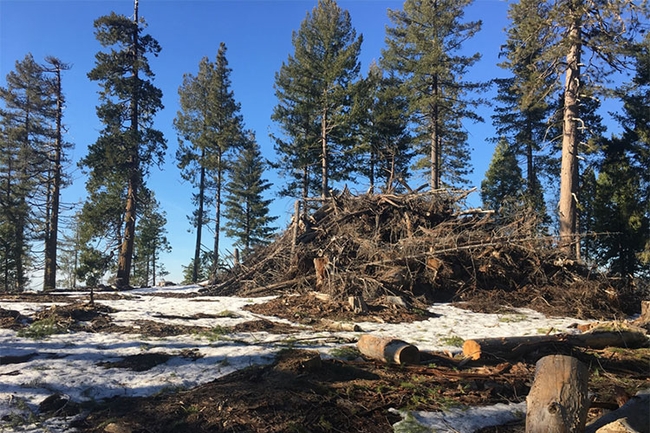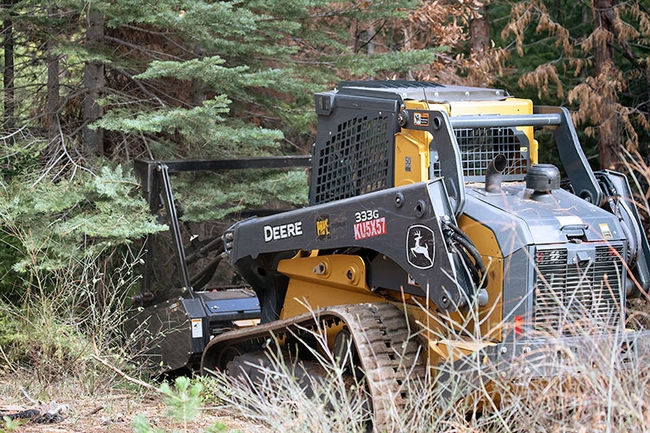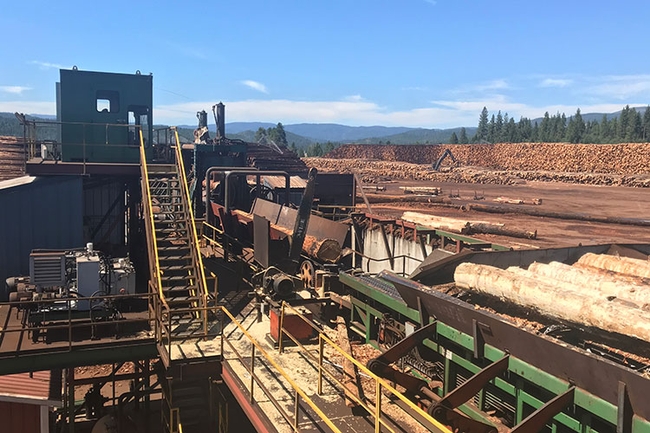
Posts Tagged: The Daniel
Munk, ‘pivotal in cotton success,’ retires after 36 years in Fresno County
Daniel Munk, UC Cooperative Extension farm advisor, retired from a 36-year career with UC Agriculture and Natural Resources on July 1.
“Dan has played a pivotal role in the success of cotton that has been grown in California, especially his work on drought-related growing conditions and how best for cotton to overcome those conditions and thrive,” said Roger Isom, president and CEO of California Cotton Ginner & Growers Association and Western Agricultural Processors Association in Fresno.
“And while I know he has been involved most recently in reduced tillage research, it is his irrigation work that he will be remembered for,” Isom said. “Dan put on numerous irrigation workshops and grower meetings over the years, and he was the cotton industry's ‘go to guy' on deficit irrigation and related topics.”
As a youngster, the Bay Area native was interested in the natural sciences so he earned a B.S. in soil and water science and an M.S. in soil science from UC Davis.
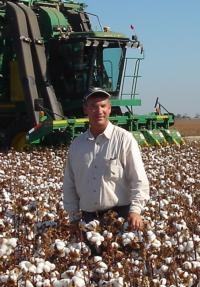
In 1990, he became a UC Cooperative Extension farm advisor in Fresno County.
“Dan has been helpful,” said John Diener, a Five Points farmer who began working with Munk in the 1990s. “If I needed anything, he was helpful, bringing information like for lygus bug or diseases or new varieties.”
To solve a salinity problem, Diener consulted Munk. “Dan was an irrigation guy and worked with USDA ARS and NRCS. This was bigger than what a local farmer can do,” Diener said, adding that Munk brought UC technical knowledge and resources from USDA Agricultural Research Service and USDA Natural Resources Conservation Service to the West Side of Fresno County to build a tile system for managing the salinity in drainage water. “It took a whole group of people to make it happen,” Diener said.
When Munk joined UC Cooperative Extension, California was growing over 1 million acres of cotton, mostly Acala varieties. During the state's six years of drought spanning the 1980s and 1990s, growers began planting the higher priced extra-long staple Pima cotton varieties instead of Upland cotton types.
In response, Munk began studying ways to improve irrigation management for Pima cotton. He and colleagues also studied plant growth regulators and found that by treating vigorously growing Pima cotton plants with plant growth regulators following first bloom, cotton yields improved by 60 to 120 pounds per acre, which translated to a $50 to $100 per-acre increase in crop value, with higher cotton quality and fewer problems with defoliation.
As water became increasingly limited in California, the state's cotton acreage plummeted and Munk turned his research to producing crops with less water using reduced tillage systems. In one study, he and his research collaborators found that they could improve water use efficiency by 37% by growing cotton in wheat residue versus conventional tillage. In other research, Munk and colleagues showed that reduced till cotton systems could reduce fuel use by more than 70%, increase soil carbon by more than 20%, and reduce dust emissions by more than 60%, relative to conventional till approaches. Another of Munk's projects suggests that garbanzos and sorghum can be grown under no-till practices in the San Joaquin Valley without loss of yield.
“He has also been helpful in issues related to nitrogen uptake and air and water quality,” Isom said.
Because of Munk's expertise in nutrient and water management practices, he was asked to serve on the state's Agricultural Expert Panel in 2014 to assess agricultural nitrate control programs. They developed recommendations for the State Water Resources Control Board to protect groundwater.
One of the recommendations was to develop a comprehensive and sustained educational and outreach program. As a result, the California Department of Food and Agriculture and UC California Institute for Water Resources created the Irrigation and Nitrogen Management Training Program, for which Munk helped develop curriculum and train growers and farm consultants on best farm practices for nitrogen and water management. Leading the program's southern San Joaquin Valley courses, he helped certify more than 300 growers, consultants and farm advisors in protecting groundwater.
“I hope these more recent programs will have lasting impacts on farm economic viability and improved groundwater quality,” Munk said.
The farm advisor also extended his irrigation knowledge beyond farms. Working with fellow UCCE advisors and specialists, Munk conducted hands-on training for school landscape staff in 2012-2013. The staff learned how to measure irrigation output, sample soil and manage water to avoid runoff and improve water quality.
“He has had a huge impact, and his work will remain instrumental in the cotton industry's survival in California as we deal with ongoing drought issues,” Isom said. “His departure will leave an empty spot in the cotton world today without a doubt!”
Bringing out the best in wild birds on farms
Natural habitat maximizes the benefits of birds for farmers, food safety and conservation
A supportive environment can bring out the best in an individual — even for a bird.
After an E.coli outbreak in 2006 devastated the spinach industry, farmers were pressured to remove natural habitat to keep wildlife — and the foodborne pathogens they can sometimes carry — from visiting crops. A study published today from the University of California, Davis, shows that farms with surrounding natural habitat experience the most benefits from birds, including less crop damage and lower food-safety risks.
The study, published in the Journal of Applied Ecology, was conducted at 21 strawberry fields along California's Central Coast. It found that birds were more likely to carry pathogens and eat berries without surrounding natural habitat.
The authors said a better understanding of the interplay of farming practices, the landscape, and the roles birds play in ecosystems can help growers make the most out of wild birds near their fields.
“Bird communities respond to changes in the landscape,” said lead author Elissa Olimpi, a postdoctoral scholar in the UC Davis Department of Wildlife, Fish and Conservation Biology at the time of the study. “As birds shift in response to management, so do the costs and benefits they provide.”
The single most important driver
The study looked at how different farming practices influenced the costs and benefits that wild birds provided on the strawberry farms. The scientists combined nearly 300 bird surveys and the molecular analyses of more than 1,000 fecal samples from 55 bird species to determine which birds ate pests, beneficial insects and crops, and carried foodborne pathogens.
They also ranked birds to see which were more likely to bring benefits or costs to farmlands. Barn swallows, for instance, got a “gold star” in the study, Olimpi said. Their mud nests are commonly seen clinging to the underside of barn eaves, from which they fly out to swoop over fields, foraging on insects.
But rather than resulting in a list of “good” and “bad” birds, the study found that most bird species brought both costs and benefits to farms, depending on how the landscape was managed.
The presence of natural habitat was the single most important driver differentiating a farm where wild birds brought more benefits than harm.
“Nature is messy, and birds are complex,” Olimpi said. “The best we can do is understand how to take advantage of the benefits while reducing the harms. Growers will tell you it's impossible to keep birds off your farm — you can't do that and don't want to from a conservation perspective. So how can we take advantage of the services birds provide?”
Win-wins for birds and farms
The study is one of several publications from UC Davis Professor Daniel Karp's lab highlighting the environmental, agricultural, and food safety impacts of conserving bird habitat around farms. A related study in 2020 found that farms with natural habitat attracted more insect-eating birds — and fewer strawberry-eating birds — so that farmers experience less berry damage on farms with more habitat nearby. Such habitats also bring greater numbers of bird species to the landscape.
“All together, these studies suggest that farming landscapes with natural habitat tend to be good for conservation, farmers, and public health,” said Karp.
Additional co-authors of this study include Karina Garcia and David Gonthier of University of Kentucky, Claire Kremen of UC Berkeley and the University of British Columbia, William E. Snyder of University of Georgia, and Erin Wilson-Rankin of UC Riverside.
The research was funded by the USDA and UC Davis Department of Wildlife, Fish and Conservation Biology.
Researchers pinpoint which bird species pose food safety risk to crops
E. coli and Salmonella are rare in wild birds, Campylobacter more common
Concerns over foodborne risk from birds may not be as severe as once thought by produce farmers, according to research from the University of California, Davis, that found low instances of E. coli and Salmonella prevalence.
While the research found that the risk is often low, it varies depending on species. Birds like starlings that flock in large numbers and forage on the ground near cattle are more likely to spread pathogenic bacteria to crops like lettuce, spinach and broccoli, according to a study of food safety risk and bird pathogens from the University of California Davis. In contrast, insect-eating species were less likely to carry pathogens.
The findings, published in the journal Ecological Applications, suggest that current practice of removing bird habitats around produce growers' farms over concerns the animals could bring foodborne pathogens into their fields may not solve the problem.
“Farmers are increasingly concerned that birds may be spreading foodborne diseases to their crops,” said Daniel Karp, the senior author on the study and an assistant professor in the UC Davis Department of Wildlife, Fish and Conservation Biology. “Yet not all bird species are equally risky.”
Only one foodborne disease outbreak in produce has been conclusively traced to birds: a Campylobacter outbreak in peas from Alaska. While the bacteria can cause diarrhea and other foodborne illness in humans, it's less of a concern to growers than E. coli and Salmonella, which have been responsible for multiple outbreaks across the nation.
In this study, researchers compiled more than 11,000 bacteria tests of wild bird feces and found that Campylobacter was detected in 8 percent of samples. But pathogenic E. Coli and Salmonella were only found in very rare cases (less than 0.5%).
In addition to the bacteria tests, researchers conducted roughly 1,500 bird surveys across 350 fresh produce fields in Western states and collected more than 1,200 fecal samples from fields. They then modeled the prevalence of pathogens in feces, interactions with crops, and the likelihood of different bird species to defecate on crops to determine risk.
Insect-eating birds pose lower risk
Based on the data, insect-eating birds, such as swallows, present a lower risk, while birds that flock near livestock, such as blackbirds and starlings, are more likely to transmit pathogens.
The data can help the agricultural industry determine risk and take action, such as separating produce crops from cattle lands. They also don't need to treat all birds the same.
“Maybe farmers don't need to be quite as concerned about all types of birds,” Karp said. “Our data suggest that some of the pest-eating birds that can really benefit crop production may not be so risky from a food-safety perspective.”
Removing habitat can backfire
This study and the authors' prior work indicate that removing habitat around farms may actually benefit the species that pose more risk and harm the beneficial, pest-eating ones that are less risky to food safety. This is because many prolific insect-eaters may visit crop fields to eat pests but need nearby natural habitats to survive. In contrast, many of the bird species that most commonly carry foodborne pathogens readily thrive on both cattle farms and produce farms without natural habitat nearby.
Other findings
Insect-eating birds that forage in the tree canopy pose minimal threat because they are less likely to carry foodborne pathogens and come into direct contact with produce. They can also be valuable parts of the ecosystem, particularly if they eat pests that can harm crops. Installing bird boxes could attract the pest-eaters, as well as help with conservation efforts.
“We basically didn't know which birds were problematic,” said lead author Olivia Smith, a postdoctoral researcher at Michigan State University who was at University of Georgia when the paper was written. “I think this is a good step forward for the field.”
Additional co-authoring institutions include James Cook University, UC Berkeley, UC Riverside, University of Kentucky, University of Texas, Virginia Polytechnic Institute and State University, Washington State University, BioEpAr, The Nature Conservancy and Van Andel Institute.
The research was funded by the United States Department of Agriculture and the National Science Foundation.
Daniel and Sarah Hrdy create endowment to fund UC Cooperative Extension research
The Yolo County walnut growers will provide as much as $100,000 per year for “practical” research
The University of California Division of Agriculture and Natural Resources (UC ANR) announced that Dan and Sarah Hrdy, owners of Citrona Farms LLC, a walnut farm in Winters, have established The Daniel & Sarah Hrdy Fund for UC Cooperative Extension Research.
The fund will provide as much as $100,000 in seed funding for early-stage research projects each year for UC Cooperative Extension advisors and specialists, as well as their academic collaborators. Dan, a former clinical professor of medicine (infectious diseases) at UC Davis Medical Center, and Sarah, a professor emerita of anthropology at UC Davis, created the fund to express their appreciation for UC Cooperative Extension's practical yet cutting edge research.
“Over the years, we have hosted a number of researchers from UC ANR, UC Davis and UC Berkeley studying topics related to sustainable agriculture, habitat restoration and wildlife conservation and have benefited both directly and indirectly from the UC Cooperative Extension network,” said Dan Hrdy. More than 20 years of UC research hosted at Citrona Farms is detailed on their website at www.citrona.com.
Research proposals will be selected by the leaders of UC ANR's Strategic Initiatives: Sustainable Food Systems; Endemic and Invasive Pests and Diseases; and Sustainable Natural Ecosystems.
Areas of special interest include:
- Sustainable Agriculture, with special regard to climate change
- Interaction of Natural Ecosystems and Agriculture
- Habitat Restoration and Conservation
- Wildfire and Forest Restoration
"The timing for this donation could not have been better as UC ANR is actively recruiting an extraordinary number of new UCCE advisors and specialists and support for their research is greatly appreciated," Wendy Powers, UC ANR associate vice president, said. “This is a great example of how local relationships build trust and support for UCCE efforts across the state."
The fund will be established with annual gifts as part of a payout from the donor's retirement account, along with a bequest that, when paid, will create a permanent endowment where the payouts will continue to fund this project. The Hrdys hope to make others aware of this method of charitable giving.
"We were able to use required payouts from a retirement account to set up this gift,” said Dan Hrdy. “I hope more people will look into doing this to help support Cooperative Extension.”
Investors who must satisfy a required minimum distribution from their retirement accounts may consider a qualified charitable distribution (QCD), said Greg Gibbs, UC ANR executive director of Development Services.
“A qualified charitable distribution is a direct transfer of funds from your IRA custodian, payable to a qualified charity, like the UC Regents/UC ANR,” Gibbs said. “Once you've reached age 72, the QCD amount counts toward your required minimum distribution for the year, up to an annual maximum of $100,000. It's not included in your gross income and does not count against the limits on deductions for charitable contributions.”
Want to limit carbon and curb wildfire? Create a market for small trees
Clearing California's forests of dense overgrowth is a critical first step for curbing catastrophic wildfire in the state. But forest restoration — whether through prescribed burning or thinning — comes at a high price: Not only are these treatments costly, but cutting down or burning vegetation can release stored carbon dioxide, accelerating the impacts of climate change.
A new analysis by researchers at the University of California, Berkeley, provides a roadmap for how the state can effectively reduce wildfire risk through forest thinning while continuing to limit its carbon emissions.
By creating a market for small diameter trees and other woody biomass — particularly by encouraging the use of long-lived “innovative wood products,” such as oriented strand board — the state can both create an economic incentive for effective forest management and prevent the carbon stored in this vegetation from entering the atmosphere.
“It's hard to manage our forests without releasing carbon,” said study first author Bodie Cabiyo, a Ph.D. candidate in UC Berkeley's Energy and Resources Group. “But if we're really efficient and careful about how we are using the wood and invest in innovative wood products that can use waste wood, then we can achieve both net carbon benefits and wildfire mitigation benefits in California.”
In 2018, former California Gov. Jerry Brown committed the state to achieving full carbon neutrality by the year 2045, a goal that will require both reducing emissions and investing in carbon sinks, such as forests, that can remove existing carbon from the atmosphere. Two years later, California and the U.S. Forest Service jointly committed to managing a total of 1 million acres of state forest land annually through thinning, prescribed burning and industrial harvesting — treatments that could send some of that carbon back into the air.
“A lot of people are pointing towards forests as a source of sucking carbon out of the air and not adding carbon to the atmosphere,” Cabiyo said. “And while the goal to manage a million acres per year is fantastic and absolutely necessary, the reality is that a million acres per year will cost a lot of money to manage, and it's still unclear where that money is going to come from.”
While data is limited on exactly how much of the state's forests are currently managed, the researchers estimate that it is currently much less than the 1 million acre-a-year target. Their analysis shows that, with the right set of policies and incentives, the use of innovative wood products could provide both the state and private landowners with necessary funding to expand forest thinning treatments while still limiting carbon emissions.
“California has been on the forefront of both climate change mitigation and adaptation,” said study senior author Daniel Sanchez, an assistant cooperative extension specialist in UC Berkeley's Department of Environmental Science, Policy, and Management. “We hope our study helps align these two goals, showing how the state can meet both its emissions reduction goals and reduce wildfire hazard, while providing a framework for managing temperate forests across the world while trying to meet the needs of a changing climate.”
Burn piles the size of school buses
To create forests that are more resilient to severe wildfire, forest managers usually focus on removing smaller trees and underbrush, leaving many of the larger and more fire-resistant trees in place. However, while larger trees can be harvested and sold to sawmills as timber, the smaller wood residues produced by forest thinning have little market value in California and are often burned or left to decay.
“If you drive through these forest treatment projects, you'll see massive burn piles that can be over 20 feet tall — the size of multiple school buses — and they're just sitting there waiting to be combusted,” Cabiyo said. “That's a lot of carbon that is going to go back into the atmosphere.”
Small trees and woody residues aren't useless, however. Industries in other parts of the world, including the southeastern U.S., create engineered lumber by mixing wood residues with adhesives and then compressing them into large sheets. This engineered lumber is strong enough for construction, and many houses in California are already built with imported engineered wood, Sanchez said.
Woody residues can also be converted in biofuel plants to create electricity or liquid fuels, and if these plants are outfitted with carbon capture technology, this energy can be produced while removing carbon dioxide from the atmosphere.
“When it comes to carbon storage or sequestration, some people focus only on what's in the forest,” Sanchez said. “We wanted to assess the carbon emissions associated with the whole life cycle of these new products.”
The study calculated future carbon emissions under both a business-as-usual scenario, assuming limited forest management, and a scenario in which the state has created a market for wood residues. To make the comparison, the researchers conducted a cradle-to-grave analysis, looking at the carbon emissions associated with every single life stage of a product — from the moment the wood is harvested until the end of the product's life.
By investing in local industries that create innovative wood products or that convert biomass into biofuels using carbon capture technology, the state could create a market for wood residues that does not add significant carbon emissions, the study found. The study also proposes a model scenario in which the state incentivizes the use of engineered wood in the construction of multi-unit affordable housing.
“If California starts doing thinning treatments at a large scale, then we're going to be producing a lot more lumber and wood residues, and where that material goes is a question,” Cabiyo said. “We found that using that new material for building affordable housing could produce massive carbon benefits, largely because those buildings otherwise would be built with steel and cement, which have significant carbon emissions associated with them.”
Thinning treatments also reduce the risk of severe wildfires that can incinerate millions of acres of vegetation at once and kill even large trees, helping California's forests maintain their long-term ability to store carbon. Study co-author Brandon Collins, a research scientist with Berkeley Forests and with the U.S. Forest Service, points out that these treatments have also been shown to provide numerous ecological benefits, including increased water availability and habitat diversity.
“Creating a market for forest biomass produced by forest thinning could reduce wildfire hazard, prevent air pollution from smoke, and potentially displace fossil fuels and increase water availability,” Collins said. “We need to deal with this small diameter biomass, and there is a solution if we could just find a way to connect the dots politically and economically.”
Additional co-authors of the study include Jeremy S. Fried of the U.S. Forest Service and William Stewart and Jun Wong of UC Berkeley. This research was supported in part by a National Science Foundation Graduate Research Fellowship and the Conservation 2.0 Program.

